Fraser
et al. (2000a) developed a technique for annual burnt area mapping of boreal forest.
The method, dubbed HANDS (Hotspot and NDVI Differencing Synergy), combines multi-temporal
change detection with active fire monitoring. In conventional spectral change
detection approaches (e.g. image differencing) a significant challenge is to establish a
threshold suitable for identifying those pixels that have undergone change. Change
detection techniques also are susceptible to producing spurious changes due to factors
other than real land cover change, such as cloud contamination, image misregistration, and
phenological variation. HANDS is designed to minimize these problems by using an annual
mask of satellite-detected fire locations to derive spatially variable thresholds for
separating burnt pixels. Since the resulting burn clusters are required to be
spatially coincident with the fire mask, change pixels not associated with burning are
largely eliminated. The processing steps required by the
procedure is shown in figure 1 and described briefly below. More detailed
information is presented in Fraser et al. (2000). An annual composite of AVHRR hotspots (Fig. 1b) is used to derive
regional-level (200x200km) difference thresholds from a pair of anniversary date, VI
composites
(Fig. 1a). The thresholds are computed from the mean and standard deviation of
the decrease in the VI for hotspot locations within each region. This liberal,
first-pass threshold separates all burned pixels as well as many non-burned pixels (Fig.
1c). The patches of potentially burned pixels are then separated using a modal filter and
grouped into contiguous burn clusters, each with a unique identity (Fig. 1d).
Hotspots contained within the clusters are used to derive local, burn-specific
differencing thresholds that again are based on the mean and standard deviation of
the observed hotspot NDVI drop (Fig.1e). In the last step, any false burn clusters
containing less than 10% hotspots are eliminated (Fig. 1f).
The above procedure for burnt area mapping requires three
types of input data: 1) pre- and post-fire composite images used for multi-temporal
differencing; 2) an annual hotspot mask; and 3) a vegetation mask or land cover
classification. A previous application of HANDS for mapping forest fire burns in
1995 and 1996 relied on NOAA/AVHRR for all three inputs (Fraser et al. 2000a).
Hotspots were composited from single date masks produced using a boreal fire detection
algorithm (Li et al. 2000). Anniversary date 10-day NDVI composites from the end of
successive fire seasons were used for differencing, while an AVHRR land cover
classification was used to mask non-forest cover. |
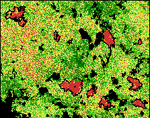 Fig1. NDVI
Differencing
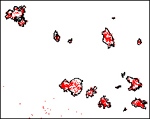
Fig 2. Conform Hotspots

Fig 3. Apply Reginal Threshold

Fig 4. Filter & Connect Burn Clusters
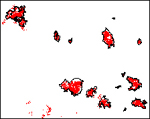
Fig 3. Apply Local Threshold
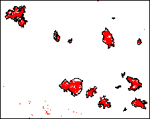
Fig 4. Eliminate False Burns
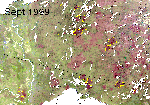
Fig 5
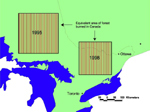
Fig 6
|